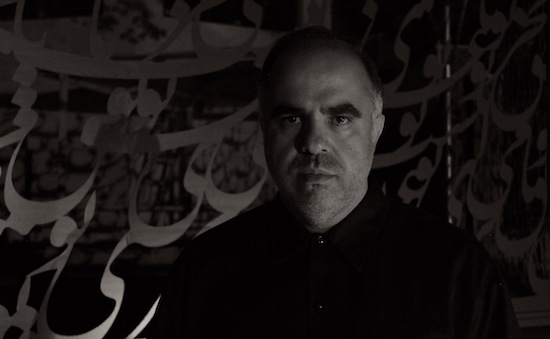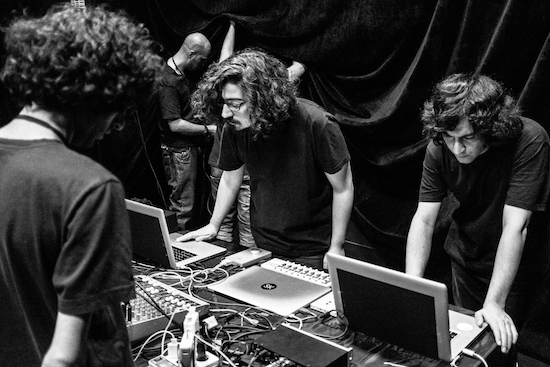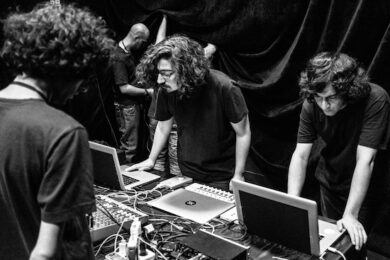Nurture may not be one of the first things that come to mind when listening to something like Sote’s Hardcore Sounds From Tehran. It’s something perhaps more often associated with warmth and patience, rather than crushing, noisy techno. Yet it’s Ata Ebtekar who first talks about nurture to me, as it plays a large part of the release, and his practice to boot.
The whoppingly heavy record is comprised of recordings from six of Sote’s performances in Tehran in the past two years – a country whose strict cultural regulations have been a major obstacle for artists for over the past four decades. Today, Iran is the site of a burgeoning experimental electronic music scene, in which Ebtekar is one of many artists working to "nurture it and bring leftfield music to a wider audience."
"I alongside eight colleagues have started an experimental art event concentrating on experimental electronic music and visual arts to provide a platform for ourselves as well as other Iranian artists who are interested in experimenting with the relationship between art and technology as well as mediums themselves."
SET Fest brings much needed sustenance to the experimental music landscape of Tehran. Ebtekar’s account of the "maniacal sonic journey" he takes listeners on characterises Side A of Hardcore Sounds as "more refined in terms of synthesis," with "a more abstract and complex form as far as the patterns and structures of the music are concerned." Side B on the other hand, he says "takes the listener to an intense journey of harsh and exciting sound systems with a relatively more straightforward feel that comes from my techno and noise background."
It’s difficult to imagine what experiencing the performances themselves would have been like, especially in a city like Tehran. Siavash Amini, a fellow musician who wrote the foreword to Hardcore Sounds says that most attendees were "alien to such music," and that the first
performance left most in "awe, and in some cases confusion."
"One thing I think is important to remember is that these performances were not raves at all. No part of any performance resembled a party. Everyone sat in the dark, moving discreetly to the music and most people were listening quite seriously. It was kind of a brain rave."
The seriousness of such an affair can be quite foreign to residents of many other big cities; the ease at which music can be heard is often taken for granted. This is something also highlighted by Ash Koosha. Ash, who crafts brilliant, textural electronic music to be heard in Guud and I AKA I, hasn’t returned to Tehran since seeking asylum in the UK. Now a self-proclaimed outsider to today’s music of Tehran, when asked about his experiences performing in the two cities, he says: "The main difference is that here, a musical event is a casual event. You listen to music, enjoy the arts and have fun. In Iran, it’s not a casual event. It’s well-prepared (if it’s legal, and most Western music is illegal in Iran). So there’s a huge element of stress. A lot of adrenalin is involved, regardless of whether you’re a performer or an audience member. At any moment you could be arrested. It’s an intense state of mind; you’re always on edge. You think, ‘what I’m doing is so big and so important. I could be arrested but I’m still here.’ The idea of having fun and having a couple beers at a gig in Dalston really isn’t the case in Iran. It’s quite the opposite – it’s a really big deal."

Some things have changed since Ash left Tehran, and now the case is a bit different for musicians like Siavash and Sote. The latter tells me, "All music that gets published officially needs to go through the Cultural Ministry for a stamp of approval and a permit, but with the current government, this situation is fading a bit. I think it’s getting better day by day. Ten years ago, it was almost impossible for young musicians to get permits, whereas now, it’s relatively easy and it’s just formality."
Amini reaffirms this: "We haven’t had any trouble getting permits or anything that has to do with the government directly. In part it’s because of the instrumental nature of most of the music we perform. You only have to get the permits when you want to perform in a public venue, and in the past couple of years we haven’t had issues with getting them at all. But that doesn’t mean the regulations aren’t ridiculous, or that everyone has the same advantage – it’s really hard for artists of certain genres to get permits. The hardest part for us is actually finding a place to perform. Even though we have permits, there are few venues willing to let us play, or that have the courage to promote such music."
"Most of the time they don’t support us with the same enthusiasm with which they support other genres of music. I think in part they are afraid of this new thing we’re doing – their fear comes from a lack of understanding around what we make, as well as ignorance about these newer forms of music performance. They’re afraid to get in trouble, either with the authorities (because of the kind of audience our shows might attract) or with the music community (since most of them don’t consider what we are doing to be music or art)."
Amini, who stumbled upon metal via his cousins, began to discover music like many of his peers through Tehran’s pirate tape culture. As consumption was heavily regulated, this was the primary avenue through which many first heard new musics. He says, "two of my cousins were listening to 70’s prog rock and heavy metal bands. The attraction for me was both visual and musical. I liked how the long-haired guys played strangely shaped guitars and banged their heads to the beat of the drums, and I was also interested in the atmospheric genius of Black Sabbath. And even the huge light shows of Pink Floyd, too. Then when dial-up internet came to town, my friends and I got deeper into extreme forms of metal that the pirate tape culture of our times missed completely – genres like doom metal and black metal."
"The real big steps towards electronic music came for me when listening to Massive Attack. I really wanted to make music that sounded like theirs, but I lacked the skills to understand what was happening in it! I started going to university to study classical guitar and met Nima Pourkarimi (Umchunga) whom I shared many interests with, so we started trading IDM albums and listening to a lot of glitch. We started performing in some venues with borrowed laptops and desktop computers."
Tehran’s pirate tape culture, according to Amini, "has died away with rise of mp3 and external hard drives. People go to each others houses and trade their collection with one another. We can’t buy anything directly, so we have to rely on free downloads, or people who go out of the country and bring music back."
"I think the good thing about the tape culture was that you couldn’t get 10 albums in a day (let alone hundreds). Having a few well-selected albums gave you the time to explore the music in depth and listen to one album hundreds of times. With digital piracy, the good thing is that you can hear many albums from many genres that can open a lot of doors for your mind. At the same time, there’s a danger in that people might just be skipping through albums as if it were a competition."
Now, Amini crafts abstract, textural musics, heard above in the melancholy ‘Nonexistent Vicinities’. He can also be heard on the opening track can of Absence, a compilation of experimental Iranian music for which he also wrote the foreword. Curated by Arash Akbari (also featured on the album) and Kate Carr, the record was released on Flaming Pines. Akbari says of the music, "I’m really interested in what’s happening right now in Iran. It’s great to hear some quality stuff come from musicians’ own experimentation. There aren’t any specific guidelines or strict learning methods to shape the whole scene into something formal and boring; that’s what I like the most about the scene."
"Of course there are lots of problems as well – financial issues, finding proper venues and even good sound systems. And in some cases there’s lack of interest among people. Pop music covers the most of need for music and sucks up all the money, attention and resources available. I guess these are the same problems experimental producers are facing around the world."
The remarkable sounds of the compilation range from Shaahin Saba Dipole’s techno-straying ‘Remembrance’ to Pouya Ehsaei’s ‘RocRast #12’ and Umchunga’s texturally rich ‘RS’. Absence provides an arousing glimpse into some of the musics emerging from Tehran today. Ata describes the scene as "young and inexperienced, but rich with individual depth and passion. Resources are limited. There are certain restrictions that need to be dissolved by education through lectures, workshops and certainly more performances."
"I truly believe that once we do more and more of workshops, lectures and performances the restrictions will be less and less. There will be more support from the cultural ministry and private sponsors." Right now, Amini describes the scene as being "at a very early stage, even though it took many of the musicians years to get where they are now. (We) were involved in different communities with different tastes. As these communities get together, I think we can see something resembling a scene shaping up.
"There are so many communities with different attitudes towards culture and art that have their own conception of experimental electronic music different form what’s happening in Tehran. That being said the the group of musicians gathered for example on the Absence album are socially, geographically and culturally related. But it as I mentioned it took time for them to all get together. That’s why in my introductory essay said that it can serve as a gateway for knowing the experimental scene and not a representation of the whole scene (if that exists after all)."
‘Alogia’ from Bescolour, or Behrang Najafi, is one of the most noteworthy tracks on the compilation, and is featured above. Noisy textures rumble and sputter over a dense ten minutes, which ventures occasionally into dub’s periphery. Najafi is also a member of duo Temp-Illusion, with Shaahin Entezaami. Their debut album is still in the works, but what they’ve shared via Soundcloud is promising. ‘Deshift’ has a delicacy about it that compliments the noise-drenched percussion well, and distortion is abundant in the fantastically hefty ‘Pressure/Sanity’.
<iframe width="100%" height="450" scrolling="no" frameborder="no" src="https://w.soundcloud.com/player/url=https%3A//api.soundcloud.com/tracks/276607960&auto_play=false&hide_related=false&show_comments=true&show_user=true&show_reposts=false&visual=”true">
The impact of IDM is notable – from Amini to Najafi and Entezaami, their sounds are undoubtedly coloured by the likes of Autechre and Aphex Twin. For Hadi Bastani too, it inspired a large part of his practice. Bastani, a researcher with a PhD in sound art and anthropology, featured on Unexplained Sounds Group’s compilation of Iranian experimental music, has produced radio programs for Resonance 104.4FM showcasing a number of Iranian musicians, and also runs a Facebook page dedicated to exposing many of these artists to a wider audience. His interests in electronic music developed along a similar path to some of his peers: "I recognised that my experience (along with my friends) with the electronic/ noise/ ambient/ IDM music certainly was not singular; that there were other people in different parts of Iran (and surely not only in Tehran) that had similar interests and experiences. That made me think that this is an emerging phenomena in the Iranian music scene."
"This labelling (EEMSI) came about as the emerging ‘sound’ has been largely based on the individual effort and experimentation, considering the lack of governmental and institutional support for this kind of music in Iran. The knowledge and influences within this scene are mainly in a form of ‘cosmopolitan musical affinities’ shaped through internet-based research, communication and exchange. It is a wonderful world constructed in Iran with such broad influences."
Idlefon’s ‘After The Quake’ is a more straightforward iteration of IDM’s imprint in Tehran. Also featured in Unexplained Sounds’ compilation, the track spans soft, abstract textures and noisy percussion, before culminating in a crescendo of noise.
Undoubtedly, these artists are influenced by their surroundings in a myriad of ways. As Sote describes, "Tehran is a city full of life and culture. I think the energy and movement that can be found in my current work is the result of living here."
"In international outreach and exchanges with other artists, organisers and festivals, I’ve witnessed growth – of ticket sales and demand – more and more younger artists are applying to perform at our events and workshops. And every time I perform, people are coming up to me to ask for lessons in synthesis, sound design and electronic music in general."
And it seems that Ebtekar and his peers’ efforts to nurture are invaluable in helping the scene progress. Like London, Tehran is a city that remarkable musics emerge from. Ash Koosha, when I asked about how he perceives the two cities, said he doesn’t necessarily see them differently; "The chaos and sound in Tehran is slightly different but it’s the same in London. If I close my eyes in Tehran, it’s likely that I would feel like I’m in London. Both are chaotic, and in them I can see chaotic objects and graphics in my head. That’s why I think my music is not Tehran or London – it’s big city life music." Without a doubt, many remarkable sounds emerge from both.



